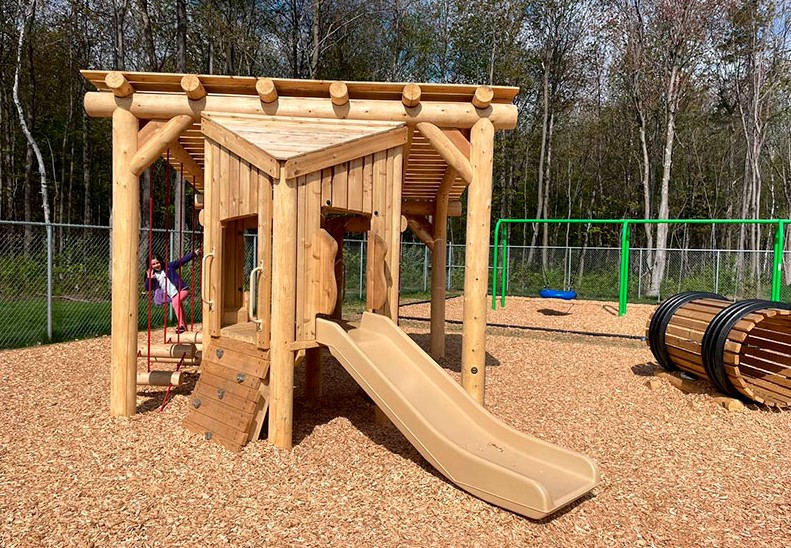Among the various materials used to build playgrounds, wood stands out for its natural aesthetics and its ability to blend into outdoor environments. Wooden playgrounds have become increasingly popular in recent years, thanks to their natural aesthetics and the numerous benefits for children’s development. However, like any material, wood has both advantages and disadvantages. This article will discuss the pros and cons of wooden playgrounds to help make an informed decision when choosing the ideal play equipment for children.
What is a Wooden playground, and what are its advantages?
Wooden playgrounds are structures designed to provide a safe and fun space for children to play. They can include a variety of equipment, such as swings, slides, tree houses, and more. Wood, a natural material, offers a warm and inviting aesthetic that blends well in natural and urban settings.
Natural Aesthetics
One of the main advantages of wooden playgrounds is their natural appearance. Wood, with its intrinsic beauty, harmoniously blends with its surroundings, creating a visually appealing and inviting space. This natural aesthetic not only enhances the playground but also fosters a deeper connection with the environment, especially in green areas and public parks.
Wood playgrounds can easily be customized to suit a community or space’s specific needs and preferences. Wood is a versatile material that allows for various designs and configurations. It brings a welcoming and natural look to any space, creating a friendlier and safer environment for children.

Sustainability
Wood, being a renewable and biodegradable resource, makes wooden playgrounds an environmentally friendly option. When obtained from sustainable sources, wood used in these playgrounds comes from forests managed with the environment in mind, reducing the overall environmental impact. This sustainability aspect can make the audience feel more environmentally conscious and responsible.
Shock Absorption
Wood’s natural ability to absorb impacts and its soft, warm touch make it a safer material for playgrounds. It reduces the risk of injury in the event of a fall, making it safer than more rigid materials like metal. This quality not only promotes children’s sensory development but also reassures parents and educators about the safety of wooden playgrounds.
Lower Heat Retention
Unlike metal, wood does not heat up as much in the sun, making it safer and more comfortable for children during hot days. This is especially important in hot climates where metal can become dangerously hot.
Disadvantages of Wooden Playgrounds
One of the main disadvantages of wooden playgrounds is the maintenance required. Wood needs to be treated regularly to prevent rot, mold, mildew, and insect damage. This may include the application of sealants, paints, and insect treatments. Wood is susceptible to pests such as termites and other insects that can cause structural damage, so it is necessary to treat the wood with specific products to prevent infestations.
Constant exposure to the elements can cause wood to crack, warp, or deteriorate over time, primarily if not adequately maintained. Likewise, wood can develop splinters, which can be dangerous to children. It is crucial to perform regular inspections and maintenance to ensure that wood surfaces are smooth and safe.
The Solution
Like any material, wood has disadvantages. However, there is a solution to minimize them and fully enjoy the playground. Properly treated wood is very resistant to weather and daily use, which guarantees a long life for the playground.
It is essential to choose a supplier that guarantees the quality of the wood, that it is suitable for the construction of playgrounds in terms of flexibility and resistance, that it is treated to withstand the weather, and that it has no defects that could cause splinters or cracks. When selecting a supplier, consider their reputation, the quality of their products, and their commitment to sustainability. Likewise, as it requires technical knowledge, the installation must be carried out by professionals to guarantee a safe and durable assembly. Ensure the installers are experienced and follow safety guidelines during the installation process.
Additionally, it is necessary to establish a maintenance plan to protect the wood and prolong the useful life of the playground. This includes regular inspections to identify any potential issues, preventive treatments such as applying sealants and insect treatments, and repairs as needed. These treatments can help protect the wood from weather and pests, ensuring the playground remains safe and enjoyable for children.
What did you think of this topic? Do you want to know more about wooden playgrounds?
If you want a wooden playground for your project, community, school, daycare, or public park, contact us by visiting the following link.